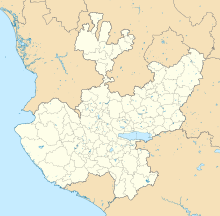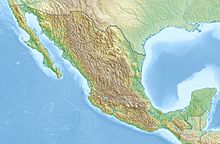Battle of Calderón Bridge
 From Wikipedia the free encyclopedia
From Wikipedia the free encyclopedia
This article includes a list of general references, but it lacks sufficient corresponding inline citations. (January 2011) |
| Battle of Calderón Bridge | |||||||
|---|---|---|---|---|---|---|---|
| Part of the Mexican War of Independence | |||||||
 Plan of the Battle of Calderón Bridge NOTE: The south is at the top, indicated by the arrow | |||||||
| |||||||
| Belligerents | |||||||
| | |||||||
| Commanders and leaders | |||||||
| Miguel Hidalgo Ignacio Allende Juan Aldama Mariano Abasolo Jose Antonio Torres | Félix María Calleja del Rey, 1st Count of Calderón Manuel de Flon † Jose de la Cruz | ||||||
| Strength | |||||||
| 90,000[1] - 100,000[2] irregulars (20,000 light cavalry) (3,000 armed with rifles) (60,000 armed with primitive weapons) 95 cannons[3] | 5,000[4][5] - 8,000 [6] regulars 10 cannons [7] | ||||||
| Casualties and losses | |||||||
| 13,000[8] | 1,000[9] | ||||||
Location within Jalisco | |||||||
The Battle of Calderón Bridge (Spanish: Batalla del Puente de Calderón) was a decisive battle in the Mexican War of Independence. It was fought in January 1811 on the banks of the Calderón River 60 km (37 mi) east of Guadalajara in present-day Zapotlanejo, Jalisco.
Almost 100,000 Mexican revolutionaries contributed to the attack, commanded by Miguel Hidalgo, Ignacio Allende, Juan Aldama and Mariano Abasolo. The Royalist forces of New Spain, made up of between 5,000 and 8,000 professional soldiers fighting for the King of Spain, were led by Félix María Calleja del Rey, a Spanish military officer and (later) viceroy of New Spain. He was also later given the title of conde de Calderón for the Spanish victory.[10]
The battle owes its name to the adjoining bridge, and the combattants' objective. The Battle of Calderón Bridge was the last militant episode of the first stage of the War of Independence.
Overview[edit]
Following Hidalgo's failed attempt to take Mexico City in October 1810, insurgent troops retreated toward Guanajuato, pursued by Royalist forces led by General Félix María Calleja. Unable to defend positions at Aculco, where Calleja's army intercepted the insurgents, Hidalgo decided to continue his army's retreat towards Guadalajara.[11]
The insurgent army, numbering approximately 100,000,[12] took up a defensive position at the Bridge of Calderón, where the road from Guanajuato to Guadalajara crossed the Calderón River. Ignacio Allende commanded the troops at this position.
Among the insurgent forces were 20,000 light cavalry, 3,000 armed with rifles, 60,000 armed with spears, slings, and arrows. Calleja's forces, which numbered between 5,000 and 8,000 but were better equipped than the insurgent forces, arrived at the Bridge on 16 January.
As the battle ensued, Royalist artillery struck an insurgent ammunitions wagon, which caused it to explode. The explosion dispersed much of the insurgent force, giving victory to the much smaller but better disciplined and equipped Royalist forces. Insurgent forces fled northwards after losing the battle with Royalist troops following them.
The insurgents' defeat in this battle effectively was a turning point in the War of Independence and resulted in a ten-year delay before insurgent victory and independence could be achieved.
Aftermath[edit]

The battle marked the end of the first stage of the war and was noted for the fact that the insurgents fought with more passion than strategy. The insurgent forces were devastated and the events that followed would lead up to the capture and ultimately the executions of Hidalgo, Allende, Aldama and Jiménez.
The insurgents fled north where, in Pabellón de Hidalgo, Hidalgo was divested of his military command in favour of Allende.[13] In March they received an invitation by the New Leonese general Ignacio Elizondo to meet at the Wells of Baján (Norias de Baján) in Coahuila, hoping they would be able to buy weapons in the United States. The first contingent arrived on 21 March with Allende, Aldama, Jiménez and Indalecio, son of Allende. They were welcomed and ambushed, and immediately taken prisoner. When the second contingent arrived with Abasolo, they were also captured and taken prisoner. Hidalgo ultimately arrived on horse and was personally apprehended by Elizondo.
The prisoners were taken to Chihuahua where they were tried. Allende, Aldama and Jiménez were shot on 26 June, Hidalgo on 30 July and Abasolo was sentenced to life in prison in Cádiz, Spain, where he died in 1816.
Calderón Bridge was declared a Mexican historical monument in 1932.
Notes[edit]
- ^ (in Spanish) Morelos. Fernando Benítez, Fondo de Cultura Económica, 1998, pp. 72.
- ^ (in Spanish)Diccionario universal de historia y de geografía. Lucas Alamán & Manuel Orozco y Berra, Imp. de F. Escalente y c.a., 1853, pp. 35.
- ^ (in Spanish) Morelos. Fernando Benítez, Fondo de Cultura Económica, 1998, pp. 72.
- ^ (in Spanish) Manual de biografía mexicana, ó Galería de hombres célebres de México. Márcos Arróniz, Paris, 1857, Librería de Rosa, Bouret y Cia, pp. 193.
- ^ (in Spanish) Morelos. Fernando Benítez, Fondo de Cultura Económica, 1998, pp. 72.
- ^ (in Spanish) El Museo mexicano, ó, Miscelanea pintoresca de amenidades curiosas é instructivas, Volumen 2. Ignacio Cumplido. Lo imprime y publica él mismo, 1843, pp. 530.
- ^ (in Spanish) Compendio de historia de México: la revolución de independencia y México independiente. Alfonso Toro, Editorial Patria, 1958.
- ^ (in Spanish) José Herrera Peña (2003). Hidalgo a la Luz de Sus Escritos: Estudio Preliminar, Cuerpo Documental y Bibliografía. Morelia, Michoacán: Universidad Michoacana de San Nicolás de Hidalgo, pp. 146. ISBN 978-9-70703-217-0.
- ^ (in Spanish) José Herrera Peña (2003). Hidalgo a la Luz de Sus Escritos: Estudio Preliminar, Cuerpo Documental y Bibliografía. Morelia, Michoacán: Universidad Michoacana de San Nicolás de Hidalgo, pp. 146. ISBN 978-9-70703-217-0.
- ^ (in Spanish) "Calleja del Rey, Félix María," Enciclopedia de México, v. 2. Mexico City: 1996, ISBN 1-56409-016-7.
- ^ Meyer, Jean (1996). Hidalgo (in Spanish). Mexico: Editorial Clío.
- ^ (in Spanish) Etapas de la Independencia de México
- ^ Krauze, Enrique (1 August 2002). Siglo De Caudillos (Trilogia Historica de Mexico) (in Spanish) (1 ed.). Barcelona: TusQuets. ISBN 970-699-048-8.
References[edit]
- Velázquez, Rogelio (2000). Historia de México (in Spanish). Mexico City: Editorial Castillo. ISBN 970-20-0019-X.
- Nieto López, José de Jesús (1998). Historia 3 (in Spanish). Mexico City: Editorial Castillo. ISBN 970-642-214-5.
- Fuentes Mares, José (1984). Historia Ilustrada de México (in Spanish). Mexico City: Editorial Océano. ISBN 968-491-045-2.
- Zárate, Julio (1889). Mécico a Través de Los Siglos (in Spanish). Mexico City: Editorial Cumbre.
- Villalpando, José Manuel (2002). Miguel Hidalgo (in Spanish). Mexico City: Editorial Planeta D'Agostini. ISBN 970-726-050-5.
- Hernández, Maite (2003). Miguel Hidalgo (in Spanish). Madrid: Editorial Dastin. ISBN 978-84-492-0327-5.
- Meyer, Jean (1996). Hidalgo (in Spanish). Mexico: Editorial Clío.
- Young, Philip (1850). History of Mexico, Her Civil Wars, and Colonial and Revolutionary Annals. J.A. & U.P. James.
- Bancroft, Hubert Hugh. History of Mexico, Vol. 4.
External links[edit]
- (in Spanish) – Official site of the Batalla del Puente de Calderón
- (in Spanish) – Inep.org: La Batalla del Puente de Calderón – (registration required)
- (in Spanish) – Redescolar.ilce.edu.mx: En Red Escolar
- (in Spanish) – Monografias.com: En Monografías

